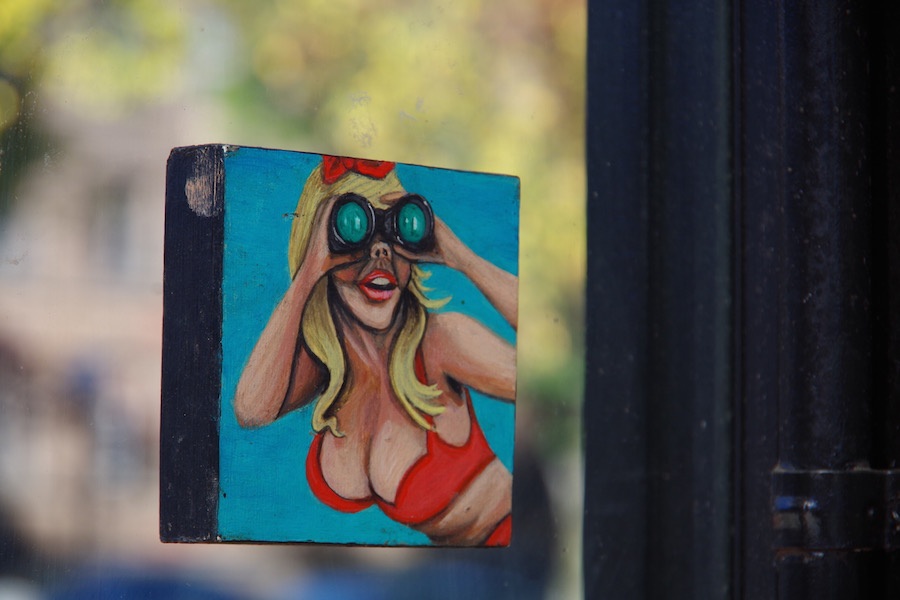
Bill Saunders | Breasts | Downtown | Arts & Culture | New Haven | Visual Arts
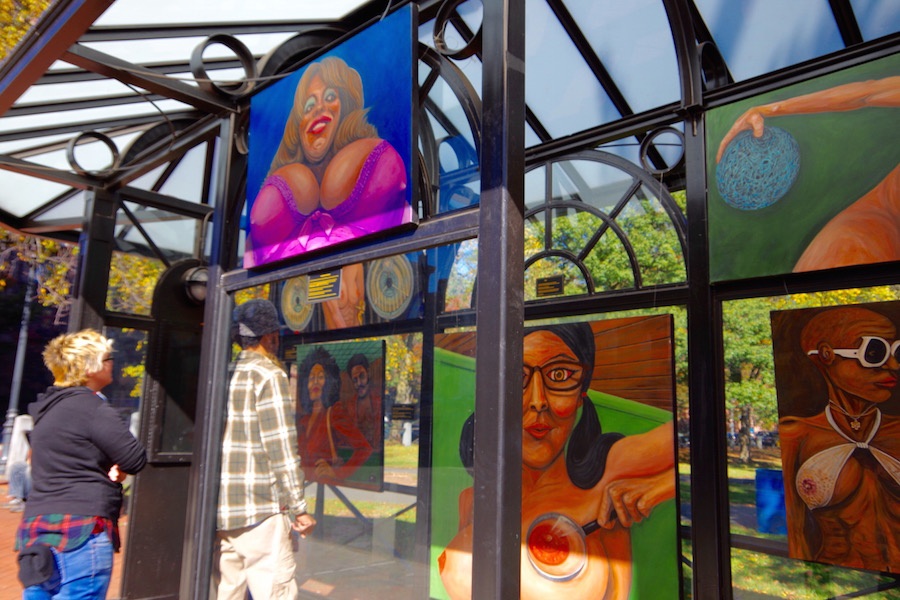 Bust Op , a one day affair that Saunders said may repeat. Lucy Gellman Photos.
Bust Op , a one day affair that Saunders said may repeat. Lucy Gellman Photos.
A New Haven artist spent Friday promoting breast cancer awareness with some busty, temporary works of public art downtown. After drawing the ire of a few city officials, he was able to keep them up for an afternoon.
That artist is Bill Saunders, known for his role in organizing New Haven’s Ideat Village and recent exhibition downtown at The Ordinary. Friday afternoon, he mounted a guerrilla art exhibition called Bust Op at the corner or College and Chapel Streets, inside and around one of the city’s covered bus stops.
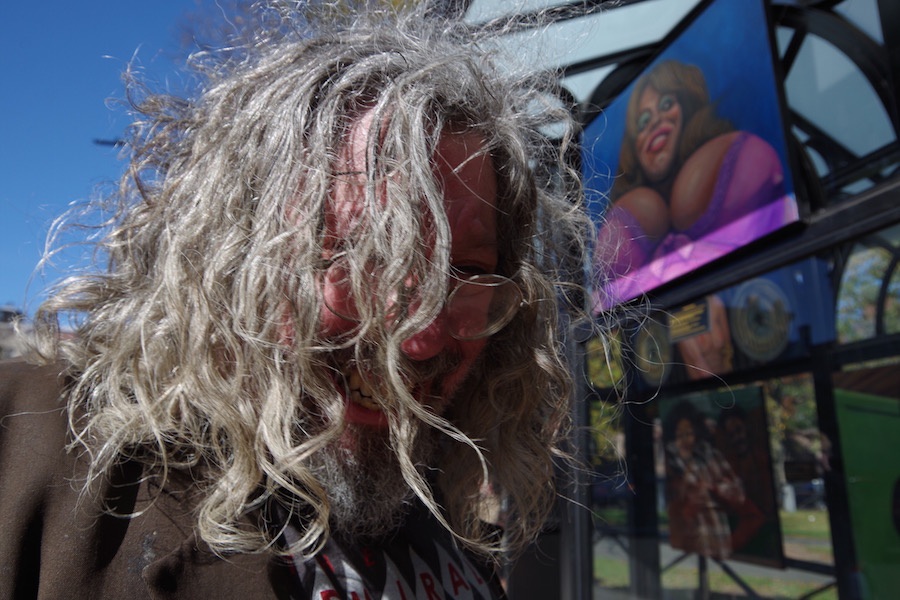 Bill Saunders, provocateur.
Bill Saunders, provocateur.
The show, he said, was an opportunity to mark and support Breast Cancer Awareness Month, which falls every October. Last year, he installed a smaller version of the show on the lower New Haven Green, where buses come more frequently than the Chapel Street location. From that show’s display of “five big-chested white women,” Saunders said he recognized a need to expand and diversify his material.
This year, Bust Op featured new paintings of Pam Grier and Richard Roundtree, both breast cancer survivors and stars in several Blaxploitation films from the 1970s. Spanish actress Lena Romay, also prominent in exploitation films, came to life in another. Saunders’ work Check, with a woman holding a magnifying glass over her nipple sat squarely at center of the stop, staring out as a sort of self-check reminder.
On the outside, Saunders hanged a panting of Kitten Natividad, a Mexican-American actress known to star in porn films, who underwent a double mastectomy in 1999. In the painting, she is staring out over her huge, bulbous breasts. A pink ribbon is fastened where they meet on her chest.
Friday, Saunders said he saw it as his duty to educate members of the public who walked by the exhibition.
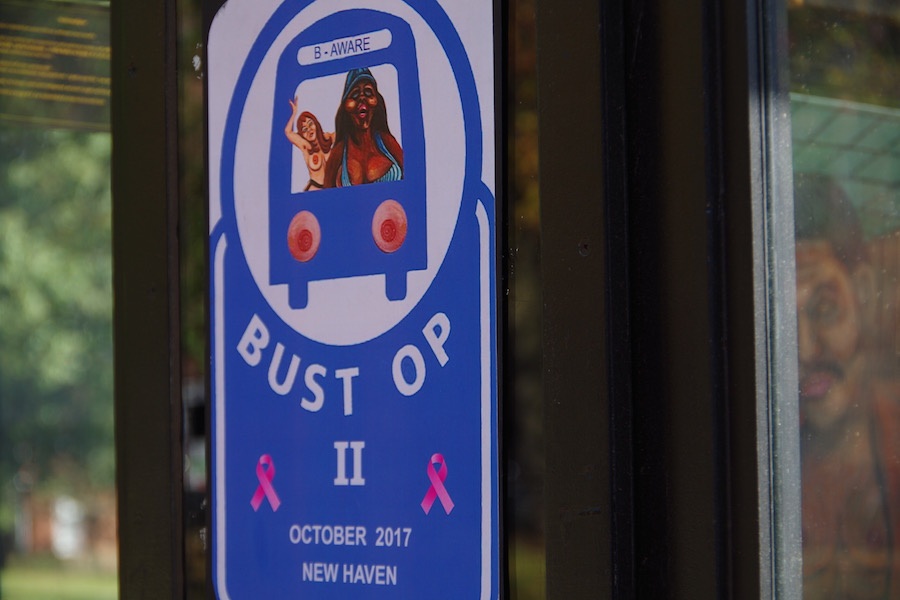
“Other than the banner on Chapel Street, I haven’t seen boo to tell people that it’s Breast Cancer Awareness Month,” he said, guarding the works as students, bus-catchers, and lunch-seekers passed by. “So bring it to the people! That’s the only way they’re going to see it. They’re not going to go into an art gallery.”
Saunders also honed in on an instructive mission. Paintings were accompanied by text, making clear the objective of the show. On both sides of the stop, he pasted facts about breast cancer (Did you know one in eight women will be diagnosed within their lifetime? What about the effects of alcohol on breast cancer? Or the fact that men get breast cancer too?).
Last year, he said he “was blown away” by the number of people who learned what the show was about, and told their stories to him on the spot. But the show also has a personal angle: Saunders was eight or ten when his Aunt Dot, his mom's cousin, had a breast removed. His mom, who is still living, also underwent multiple surgeries to remove “lumps and bumps” that she found over several years.
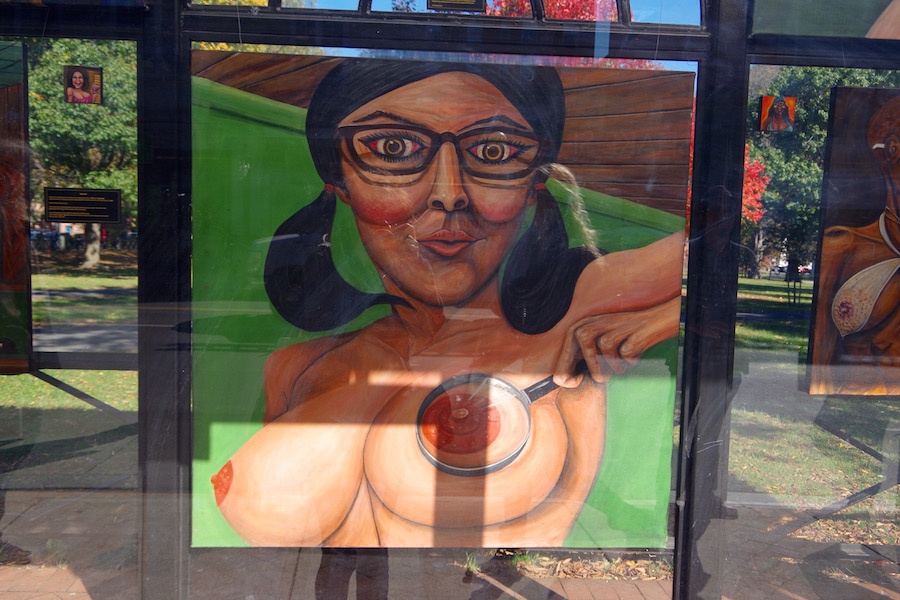 Check.
Check.
Then last year, a friend of his who had been living in Spain reconnected with him during his exhibition "Don't Call Me Baby" at The Ordinary. She had moved back to the U.S. to take care of her dad, and was getting treated for breast cancer. She showed Saunders a mastectomy scar and her mammogram, recounting stories of the disease and treatment. For Saunders, "that was the dose of reality that set my sail right."
“It affected me in a deep, deep way,” he said. “It’s a hard subject matter. All I can do is hope that I can be a conduit to the compassionate expressions of a universal trauma.”
As Parks, Recreation and Trees crews installed a 65 foot, 10,500 pound Christmas tree one street over, Saunders’ scene attracted curiosity on Chapel Street. Waiting for the 246 bus to spirit him up Edgewood Avenue, Rafael Gottleib ducked inside the stop, reading about his risks of contracting the disease as a man. As the bus pulled up Chapel, he gave Saunders a little nod.
“It was unexpected, though I liked it,” he said. “I hope when people walk by, they notice this.”
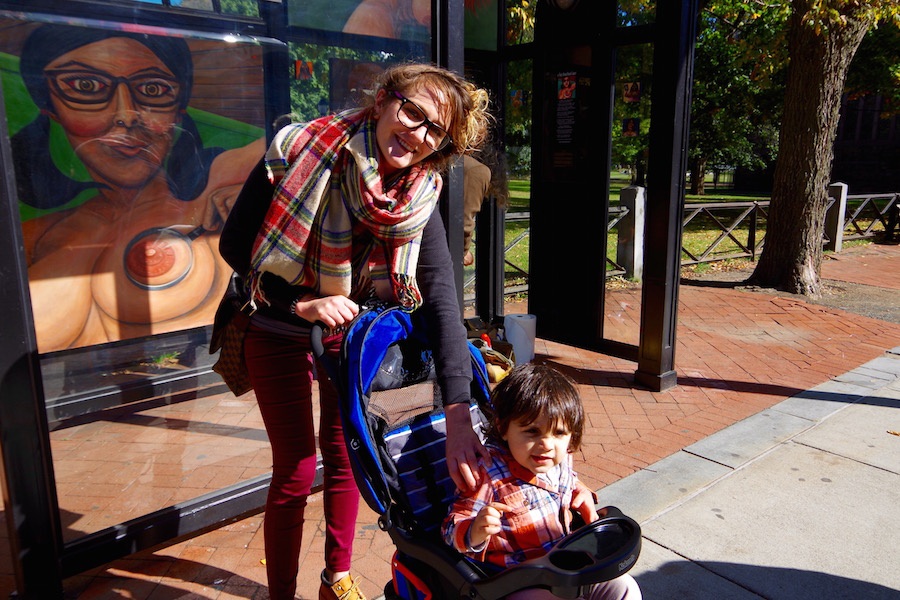 Ellington with Isias. "Bee bees" out in the open is a-ok with them.
Ellington with Isias. "Bee bees" out in the open is a-ok with them.
“I think it’s good,” chimed in Maria Ellington, who had stopped to look at the paintings on a walk downtown with her young son, Isias. When she and Isias had arrived downtown hours earlier, Saunders was just parking behind them, and encouraged her to check out the installation while it was still up.
“It brings awareness to breast cancer, which runs in my family,” she said. “It’s actually a reminder—I need to get a mammogram this year. I’m 28.”
She recalled watching her grandmother, a woman “who took a lot of pride in her appearance” lose her hair to breast cancer several years ago. “I couldn’t do that,” she said. She turned back to Isias, pointing out the “bee bees”—that’s what the two say for breasts—popping out from the corner.
But not everyone was so happy with the show. Just half an hour in to the exhibition, Transportation, Traffic & Parking Deputy Director Michael Pinto stopped by the exhibition, with a long face. “Take it down, Bill,” he ordered.
“Please hear me out,” Saunders said.
“When’s it coming down?” Pinto countered. He said that his concern didn’t originate in the exhibition itself, so much as the lack of explanatory materials outside of the bus stop. From the street, he explained, it just looked like larger-than-life portraits of breasts, all in cartoon-like color.
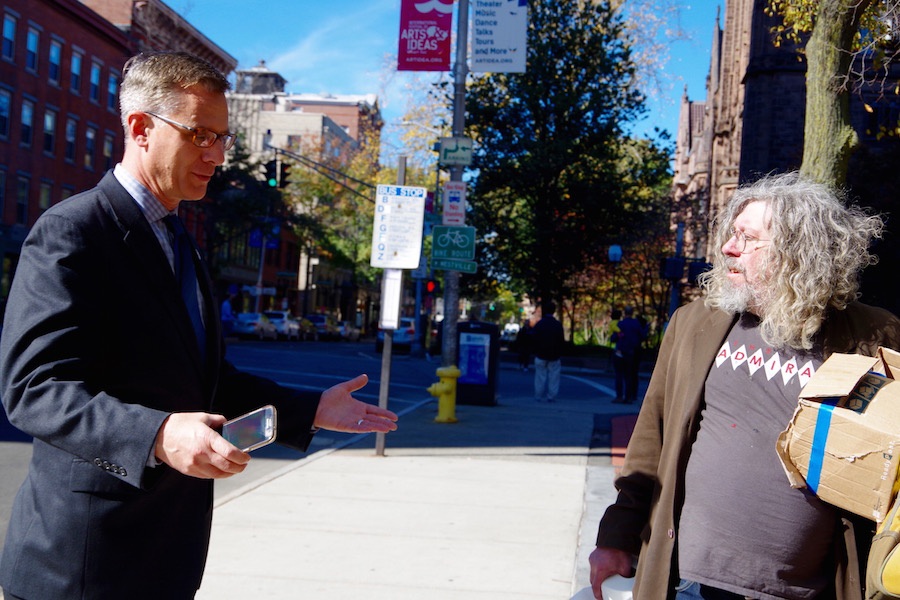 Public art, or public indecency? Saunders and Pinto face off.
Public art, or public indecency? Saunders and Pinto face off.
“Go in. Experience the art,” Saunders encouraged him. Pinto showed no sign of moving from his place in the sidewalk.
“It’s free speech!” Saunders continued. “How can you regulate it? This is an open, public space — it’s for the public!”
Pinto suggested that Saunders needed a permit, which he did not have.
“This is bullshit, Michael, and you know it,” he continued. “I’m not kowtowing to this.”
Pinto suggested that he might call for backup if Saunders didn’t take the exhibition down. Saunders shook his head. Calling the cops was fine with him, he said.
As Pinto walked back up Chapel Street, he declined to give any comment to the press. “I have no comment. The city has to do its job,” he said.
Back at Bust Op, Saunders shrugged. “This is why you can’s ask for permission for anything in this town,” he said.

As Saunders kept an eye out for police—they never came—he continued to mingle with passers-by. Putting fellow artist and installer Stina on watch duty, he ran across the street to Shake Shack, where a woman was standing with a puzzled look on her face. His voice, explaining that it was an exhibition geared toward breast cancer awareness, carried across the street. He guided her back over to the show.
“I was sitting there, thinking ‘What the hell is this!?’” said the woman, who asked that her name be withheld. “Across the street, it just looks like sexual stuff. It’s nice, though. It really is awareness.”
A silver van with a blue CT Transit logo pulled up to the stop, and rolled down the window.
Saunders shuffled over to the officer. From her place on the side of the stop, Stina guffawed. “There’s nothing suggestive here,” she said. “Breasts are a part of life. Breasts are life.”
.jpg)
.jpg)
Back over at the curb, Saunders smiled and stuck his head into the car’s open window.
“What are you doing to our bus stop?” asked the transit officer.
“It’s for Breast Cancer Awareness Month!” Saunders replied.
“Oh, cool,” the officer said. Then he drove off. Saunders later said that an agreement had been reached with Pinto to keep the show up through 5 p.m. Friday.
Back in the stop, a couple was arguing over the phone about whether the paintings should stay up. Jhamal Gallimore, Sr. had been on his way to the bank when he saw the paintings, and jogged across the street to take a better look. He’d called his friend Tawana over FaceTime to talk about it. The two were now locked in an argument over whether the show was too scandalous or not.
Saunders headed over to Gallimore and held out his hand.
“Let me talk to her,” he said.
To check out an article on the same show in the New Haven Independent, click here.

